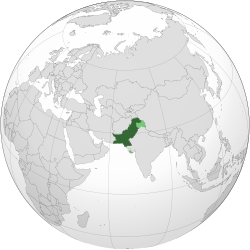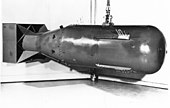
Back باكستان وأسلحة الدمار الشامل Arabic Armas de destrucción masiva en Pakistán Spanish Pakistanin joukkotuhoaseet Finnish Arsenal nucléaire du Pakistan French תוכנית הגרעין של פקיסטן HE Pakistan dan senjata pemusnah massal ID Broń jądrowa Pakistanu Polish پاکستان تے وڈے پیمانے اُتے تباہی پھیلانے والے ہتھیار PNB پاکستان او د ډله ييزو وژنو وسلې Pashto/Pushto Paquistão e as armas de destruição em massa Portuguese
| Pakistan | |
|---|---|
 | |
| Nuclear program start date | 20 January 1972 |
| First nuclear weapon test | 28 May 1998 (Chagai-I)[1] |
| First thermonuclear weapon test | 28 May 1998 (Chagai-I)[2] |
| Last nuclear test | 30 May 1998 (Chagai-II) |
| Largest yield test | 40 kt in 1998 (PAEC claim)[3][4][5][2] |
| Total tests | 6 detonations[1] |
| Peak stockpile | 170 warheads (2024 estimate)[6] |
| Current stockpile | 170 warheads (2024 estimate)[7] |
| Maximum missile range | 2750 km (Shaheen-III)[8] |
| NPT party | No |
| Nuclear weapons |
|---|
 |
| Background |
| Nuclear-armed states |
|
Pakistan is one of nine states that possess nuclear weapons. Pakistan began developing nuclear weapons in January 1972 under Prime Minister Zulfikar Ali Bhutto, who delegated the program to the Chairman of the Pakistan Atomic Energy Commission (PAEC) Munir Ahmad Khan with a commitment to having the device ready by the end of 1976.[9][10][11] Since PAEC, which consisted of over twenty laboratories and projects under reactor physicist Munir Ahmad Khan,[12] was falling behind schedule and having considerable difficulty producing fissile material, Abdul Qadeer Khan, a metallurgist working on centrifuge enrichment for Urenco, joined the program at the behest of the Bhutto administration by the end of 1974. Producing fissile material was pivotal to the Kahuta Project's success and thus to Pakistan obtaining the capability to detonate a nuclear weapon by the end of 1984.[13][14]
The Kahuta Project started under the supervision of a coordination board that oversaw the activities of KRL and PAEC. The Board consisted of A G N Kazi (secretary general, finance), Ghulam Ishaq Khan (secretary general, defence),[15] and Agha Shahi (secretary general, foreign affairs), and reported directly to Bhutto. Ghulam Ishaq Khan and General Tikka Khan[16] appointed Major General Ali Nawab as the ranking engineer on the program. Moderate uranium enrichment for the production of fissile material was achieved at KRL by April 1978.[17] Eventually, the supervision passed to Lt General Zahid Ali Akbar Khan in President General Muhammad Zia-ul-Haq's administration.
Pakistan's nuclear weapons development was in response to the loss of East Pakistan in 1971's Bangladesh Liberation War. Bhutto called a meeting of senior scientists and engineers on 20 January 1972.[18][19] Bhutto was the main architect of this programme, and it was here that Bhutto orchestrated the nuclear weapons programme and rallied Pakistan's academic scientists to build an atomic bomb in three years for national survival.[20]
At the meeting, Bhutto also appointed Munir Ahmad Khan as chairman of PAEC, who, until then, had been working as director at the nuclear power and Reactor Division of the International Atomic Energy Agency (IAEA), in Vienna, Austria. In December 1972, Abdus Salam led the establishment of Theoretical Physics Group (TPG) as he called scientists working at ICTP to report to Munir Ahmad Khan. This marked the beginning of Pakistan's pursuit of nuclear deterrence capability. Following India's surprise nuclear test, codenamed Smiling Buddha in 1974, the first confirmed nuclear test by a nation outside the permanent five members of the United Nations Security Council, the goal to develop nuclear weapons received considerable impetus.[21]
Finally, on 28 May 1998, a few weeks after India's second nuclear test (Operation Shakti), Pakistan detonated five nuclear devices in the Ras Koh Hills in the Chagai district, Balochistan. This operation was named Chagai-I by Pakistan, the underground iron-steel tunnel having been long-constructed by provincial martial law administrator General Rahimuddin Khan during the 1980s. The Pakistani Atomic Energy Commission reported that the five nuclear tests conducted on May 28 generated a seismic signal of 5.0 on the Richter scale, with a total yield of up to 40 KT (equivalent TNT). Dr. A.Q. Khan claimed that one device was a boosted fission device and that the other four were sub-kiloton nuclear devices. The last test of Pakistan was conducted at the sandy Kharan Desert under the codename Chagai-II, also in Balochistan, on 30 May 1998. Pakistan's fissile material production takes place at Nilore, Kahuta, and Khushab Nuclear Complex, where weapons-grade plutonium is refined. Pakistan thus became the seventh country in the world to successfully develop and test nuclear weapons,[22] although according to a letter sent by A.Q. Khan to General Zia, the capability to detonate a nuclear bomb using highly enriched uranium as fissile material produced at KRL had already been achieved by KRL in 1984.[13][14]
- ^ a b "Pakistan Nuclear Weapons – A Chronology". Federation of American Scientists (FAS). FAS (Pakistan Nuclear Weapons – A Chronology). Archived from the original on 2012-04-27. Retrieved 2012-05-05.
- ^ a b "Pakistan Nuclear Weapons: A Brief History of Pakistan's Nuclear Program". Federation of American Scientists. 11 December 2002. Retrieved 2019-10-30.
- ^ Cite error: The named reference
faswas invoked but never defined (see the help page). - ^ Sublette, Carey (10 September 2001). "1998 Year of Testing". Nuclear Weapon Archives. Archived from the original on 2013-01-01. Retrieved 2013-01-12.
- ^ Approximating and calculating the exact, accurate and precise yields are difficult to calculate. Even under very controlled conditions, precise yields can be very hard to determine, and for less controlled conditions the margins of error can be quite large. There are number of different ways that the yields can be determined, including calculations based on blast size, blast brightness, seismographic data, and the strength of the shock wave. The Pakistan Government authorities puts up the yield range from 20-~40kt (as noted by Carey Sublette of the Nuclear Weapon Archives in her report. The explosion measured 5.54 degrees on the Richter magnitude scale, the PAEC provided the data as public domain in the KNET sources.
- ^ "Nuclear Notebook: Pakistan nuclear weapons, 2023".
- ^ "Nuclear Notebook: Pakistan nuclear weapons, 2023".
- ^ "Test launch of Pakistan's 'Shaheen-III' surface-to-surface ballistic missile successful". mid-day. 9 March 2015. Archived from the original on 2016-03-04. Retrieved 2016-04-26.
- ^ Weissman, Steve R. and Herbert Krosney, The Islamic Bomb. New York: Times Book). 1981: page 45.
- ^ Chakma, Bhumitra, pg 42, The Politics of Nuclear Weapons in South Asia, Ashgate Publishing Company, Burlington, VT, USA, 2011
- ^ A. Q. Khan (19 January 2015). "An indomitable man". The News International. Archived from the original on 2015-07-25. Retrieved 2016-04-26.
- ^ Chaudhry, MA (10 June 2006) [originally published in Defense Journal on May 2006]. "Pakistan's Nuclear History: Separating Myth from Reality". Posted by A. Gill. Archived from the original on 2013-11-06. Retrieved 2013-01-09 – via Owl's Tree.
- ^ a b Levy, Adrian and Catherine Scott-Clark, Deception: Pakistan, the United States, and the Secret Trade in Nuclear Weapons. New York. Walker Publishing Company. 1977: page 112. Print.
- ^ a b A. Q. Khan (26 May 2014). "A historic day (Part - I)". The News International. Archived from the original on 2014-08-10. Retrieved 2016-04-26.
- ^ A. Q. Khan (26 January 2015). "An indomitable man (Part - II)". The News International. Archived from the original on 2015-07-26. Retrieved 2016-04-26.
- ^ A. Q. Khan (11 July 2011). "Defenders of Pakistan". The News International. Archived from the original on 2015-07-01. Retrieved 2016-04-26.
- ^ Khan, A. Quadeer (4 August 2014). "Unsung heroes". The News International. Archived from the original on 2014-08-04.
- ^ Khan (2012, pp. 174–178)
- ^ Rehman (1999, pp. 16–17)
- ^ "Bhutto was father of Pakistan's nuclear weapons programme". Archived from the original on 2012-03-14. Retrieved 2011-04-11.
- ^ Ahmad, Mansoor; Shabbir, Usman; Khan, Syed Ahmad H (2006). "Multan Conference January 1972: The Birth of Pakistan's Nuclear Weapons Program". Pakistan Military Consortium. 1 (1). Islamabad, Pakistan: 16. Archived from the original on 2022-03-19. Retrieved 2010-11-10.
- ^ "Pakistan Nuclear Weapons". Archived from the original on 2007-02-20. Retrieved 2007-02-22.
